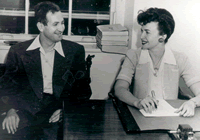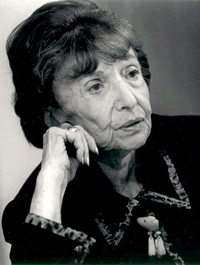A Promise That Spans Half A
Century
NEW YORK, July 6 2000 - When
her brother Bernard was diagnosed with multiple sclerosis, a potentially
disabling disorder of the central nervous system, Sylvia Lawry refused to
accept the hopeless medical verdict of "no cure or adequate treatment" for
the disease. On May l, l945, she placed a one-line ad in The New York
Times in an effort to find someone who had recovered from the disease.
When the more than 50 replies she received were from individuals like her,
desperate to find encouraging news about MS, Sylvia Lawry realized the
need for an organized effort to stimulate and finance research into the
 |
|
Sylvia Lawry and her late brother, Bernard who had MS, in
the Society' s first office at the NY Academy of
Medicine |
cure, treatment, and cause
of multiple sclerosis. The result was that on March 11, l946, Sylvia
Lawry, then in her late twenties, gathered 20 of the nation's most
prominent research scientists (all male) and founded what would become the
National Multiple Sclerosis Society.
Over the next half century,
the Society has grown into an unparalleled resource on multiple sclerosis
with 660,000 members. It annually devotes nearly $25 million to support
more than 300 research projects around the world. Since it's founding in
l946, the Society has invested over $285 million to advance MS research.
The Society has also developed a 50-state network of l35 chapters and
branches that offer a broad range of client services and assist more than
a million people annually. Realizing that MS is a worldwide problem, Ms.
Lawry went on to found the International Federation of Multiple Sclerosis
Societies (IFMSS) on August 9, l967. Headquartered in London, the IFMSS
now has 38 member countries.
Though Bernard's health
continued to weaken, and he ultimately succumbed to MS-related causes in
l973, Sylvia saw there were millions of others like her brother who also
needed help. Through her efforts and those of Senator Charles Tobey of New
Hampshire, whose daughter had MS, Congress was prevailed upon to adopt
legislation on August l5, l950, establishing what is now the National
Institute of Neurological Disorders and Stroke (NINDS). Up to this time,
government interest in MS was minimal with research expenditures totaling
approximately $l4,000. Since then, government appropriations to the
Institute have steadily mounted, until today they have passed the $900
million mark, $100 million of which impacts directly on multiple
sclerosis.
This is a very exciting time
in MS research, the FDA has already approved three medications,
Betaseron®, Avonex®, and Copaxone® for those with relapsing MS. These are
the first treatments to affect the underlying disease course not merely
manage its symptoms. For the majority of people on the drugs, results show
that there are notably fewer accumulations of MS lesions in their brains
compared to those who are not on the medications and there are indications
that the medications slow the progress of the disease. In addition, there
are more than 70 substances currently in various stages of testing
internationally. None of this would likely be happening if it were not for
Sylvia.
 |
| Sylvia Lawry,
founder-executive director of the National MS Society
1999 |
Ms. Lawry served under the
title Executive Director of the National MS Society until l982. She
continues to be an Officer of the National Board and is a full-time
volunteer, devoting her efforts to the Society's international programs.
Ms. Lawry still works a l2+ hour day to encourage new and expanded
research programs and to improve services for those with MS and their
families. "I can't retire," says Sylvia, "until the disease is retired."
|